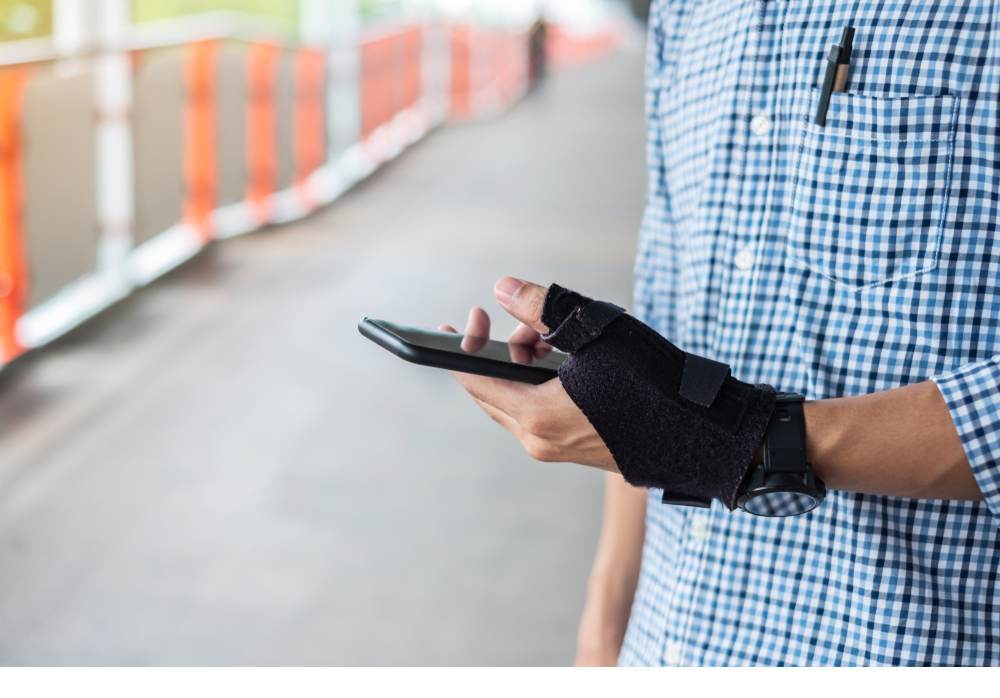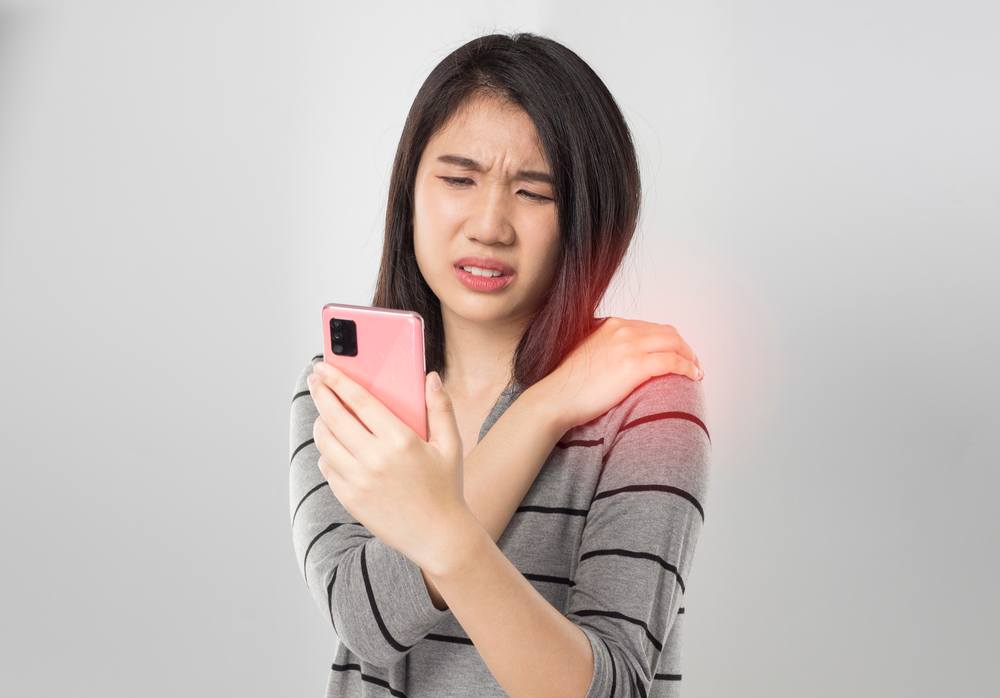 With increased dependence on phones, tablets, and other electronic devices, it is no wonder that people are experiencing more hand and wrist strain. Smartphone tendonitis refers to a real condition that can occur when you spend a lot of time on your smartphone or handheld device. People hold their smartphones in different ways, and some use add-on features on the back of a case to help get a better grip on the device. However, holding a smartphone in your hand and engaging one or two fingers repeatedly can actually put stress and strain on muscles, tendons, and other structures in your hands and wrists.
With increased dependence on phones, tablets, and other electronic devices, it is no wonder that people are experiencing more hand and wrist strain. Smartphone tendonitis refers to a real condition that can occur when you spend a lot of time on your smartphone or handheld device. People hold their smartphones in different ways, and some use add-on features on the back of a case to help get a better grip on the device. However, holding a smartphone in your hand and engaging one or two fingers repeatedly can actually put stress and strain on muscles, tendons, and other structures in your hands and wrists.
Unlike computer usage or even typewriter usage before that, smartphones can activate a unique type of tendonitis because of the way we hold our phones and put a concentrated strain on only one or two digits. The most common fingers we engage while using smartphones are the thumbs, though even the way we hold our phones can cause pain and tension in the wrists and forearms. Here’s everything you need to know about smartphone tendonitis and how it might be affecting you.
How Smartphones Can Cause You Pain
You likely have your phone in your hand while reading this, or it is probably very close by. Pick up your phone and take a closer look at how you naturally hold your phone. Do you hold it in the palm of one hand with your thumb hovering over the front screen? Or do you hold it between both hands with both thumbs on the screen? Now go through some common motions, like checking your messages or opening the camera. Notice how much you engage your thumb and how your hand and wrist subtly move to accommodate these movements. While this might not seem like much, repetitive movements like this over time can lead to tension and inflammation that can cause pain and discomfort. Whether you depend on your phone for social engagement or need it to do your job, it is important to note how frequent phone use might be causing you pain. Frequently engaging the thumbs while using your phone does not just affect those fingers. Muscles, tendons, and ligaments connect your thumbs and other fingers to your wrist and arms, so overuse and strain in one area can also lead to pain and discomfort elsewhere.
Hand & Wrist Tendonitis
Tendonitis refers to inflammation of tendons and can affect your fingers, hands, and wrists. The tendons that connect muscles in your forearm with the bones in your hand can become inflamed and aggravated with overuse and repetitive movements. When you hold your smartphone, you likely bend your wrist forward toward you while you use the device. This flexed position might not seem like a lot, but when you do it often enough, it can put tension and strain on the wrist. The wrist includes multiple tendons that connect muscles and bones in your forearm and hand. Wrist pain is common with smartphone tendonitis and can also be linked to other types of hand and wrist tendonitis and inflammation in the area.
De Quervain’s tendinosis refers to inflammation of tendons in the thumb. Swelling of these tendons can lead to friction, which makes common thumb movements more difficult and uncomfortable. In fact, de Quervain’s tendinosis is one of the most common causes of tendon inflammation and commonly occurs in women. Before smartphones, de Quervain’s tendinosis was associated with repetitive grasping motions, overuse, or a direct blow to the thumb area. Certain sports like tennis, racquetball, and skiing can also make you more likely to develop de Quervain’s tendinosis. Inflammatory conditions like arthritis have also been known to trigger de Quervain’s tendinosis. Symptoms typically include pain and tenderness along the side of the wrist closest to the thumb. Pain will typically get worse when you engage the thumb and can travel into the wrist and lower arm. Movements like grasping or pinching objects can become more painful or difficult. As you can see, many of these movements are also associated with how we engage our thumbs regularly when using a smartphone.
Symptoms of Smartphone Tendonitis
 Common symptoms of smartphone tendonitis include pain, swelling, tingling, and numbness in your fingers, wrist, and forearm. While scrolling, tapping, and typing, you may overuse certain fingers and develop symptoms in that same hand, wrist, and forearm. One of the most common areas to experience these symptoms is in the thumbs, which many people engage while using their smartphones. You may notice pain in the fatty part of your hand below the thumb after using your phone for a long period of time. Depending on how you hold your phone, you can also stress other fingers. Smartphone tendonitis can also cause your pinky finger to get a pins and needles sensation. Tingling and numbness in the pinky finger occur when the ulnar nerve that runs from your forearm and into your hand becomes aggravated by repetitive movements or overuse. When you spend a lot of time on your phone, you might also notice the hand you more commonly use becomes stiff and you feel the need to shake it out after a while.
Common symptoms of smartphone tendonitis include pain, swelling, tingling, and numbness in your fingers, wrist, and forearm. While scrolling, tapping, and typing, you may overuse certain fingers and develop symptoms in that same hand, wrist, and forearm. One of the most common areas to experience these symptoms is in the thumbs, which many people engage while using their smartphones. You may notice pain in the fatty part of your hand below the thumb after using your phone for a long period of time. Depending on how you hold your phone, you can also stress other fingers. Smartphone tendonitis can also cause your pinky finger to get a pins and needles sensation. Tingling and numbness in the pinky finger occur when the ulnar nerve that runs from your forearm and into your hand becomes aggravated by repetitive movements or overuse. When you spend a lot of time on your phone, you might also notice the hand you more commonly use becomes stiff and you feel the need to shake it out after a while.
How to Treat Smartphone Tendonitis
As inflammation develops in your thumbs, hands, and wrists, smartphone tendonitis can start to impact your everyday life. You may be able to manage smartphone tendonitis with home remedies if you catch it before the pain becomes too severe. Resting the area is key to allowing inflammation and swelling to go down naturally. While you may rely on your smartphone for many aspects of your daily routine, you may need to pivot to using more voice prompts and dictation options, along with limiting the amount of time you spend holding your phone. Taking frequent breaks and stretching your fingers and hands will help reduce pain and stiffness in the area. Over-the-counter anti-inflammatory medications can also help reduce any inflammation and swelling in the area.
In some cases, you may require more intervention to effectively resolve your pain and discomfort from smartphone tendonitis. Along with rest and medication, your doctor may recommend other ways to reduce pain and inflammation safely and effectively. Icing the area while holding your hand above your heart can help reduce inflammation and swelling. Your doctor may talk to you about using a splint or brace to help stabilize your hand and wrist. Splinting also reduces certain movements that may aggravate tendonitis and inflammation. Your doctor may also recommend a physical therapist or occupational therapist to help with strength and mobility in your hand, wrist, and fingers. Learn how to effectively engage in everyday movements like typing on your phone or grasping objects with less pain. Stretches and exercises will help strengthen muscles that support your hands and wrists while also improving your range of motion and flexibility.
In rare cases, surgical treatments may be recommended for advanced tendonitis or conditions like de Quervain’s tendinosis. Surgery is typically only recommended when non-surgical treatments have not successfully relieved pain, swelling, and inflammation. If your doctor recommends surgery, it may be an outpatient procedure and require only mild sedation. A surgery for de Quervain’s tendinosis, for example, would involve cutting the sheath where the tendons pass through to help them move more easily. Goals for this type of surgery include resolving your pain and restoring a healthy range of motion to your thumb, hand, and wrist.
Preventing Tendonitis from 21st Century Technology
So how can you prevent tendonitis from smartphones and other advanced technologies of the 21st century? While your smartphone obviously isn’t going away, the way you interact with it and other handheld devices can change. Start incorporating more breaks into your routine and avoiding activities that cause you pain. This might look like setting the alarm on your phone every 30 minutes to remind you to set the phone down and move around. Practice gentle and effective stretches to help support your fingers, hands, and wrists. Simply shaking out your hands and moving around for a bit will help restore blood flow to the area and give your muscles and tendons a break from tension and repetitive movements. If using a smartphone or tablet for long hours is simply part of your job, then talk to your doctor about splints or braces to help provide additional stability and support to help prevent smartphone tendonitis.
As new technologies continue to emerge and impact us in new and challenging ways, our team at AICA Orthopedics is here to help. Visit AICA Orthopedics in Tucker to experience quality, comprehensive treatment and care for a wide variety of injuries and health conditions. Don’t let pain keep you from going about your day. Through better usage habits, we can help you target smartphone tendonitis and experience lasting pain relief. We will also work with you to prevent any further damage to tendons or joints in the area that could be at risk due to smartphone tendonitis. Call or schedule an appointment online with a doctor at AICA Orthopedics in Tucker today.
